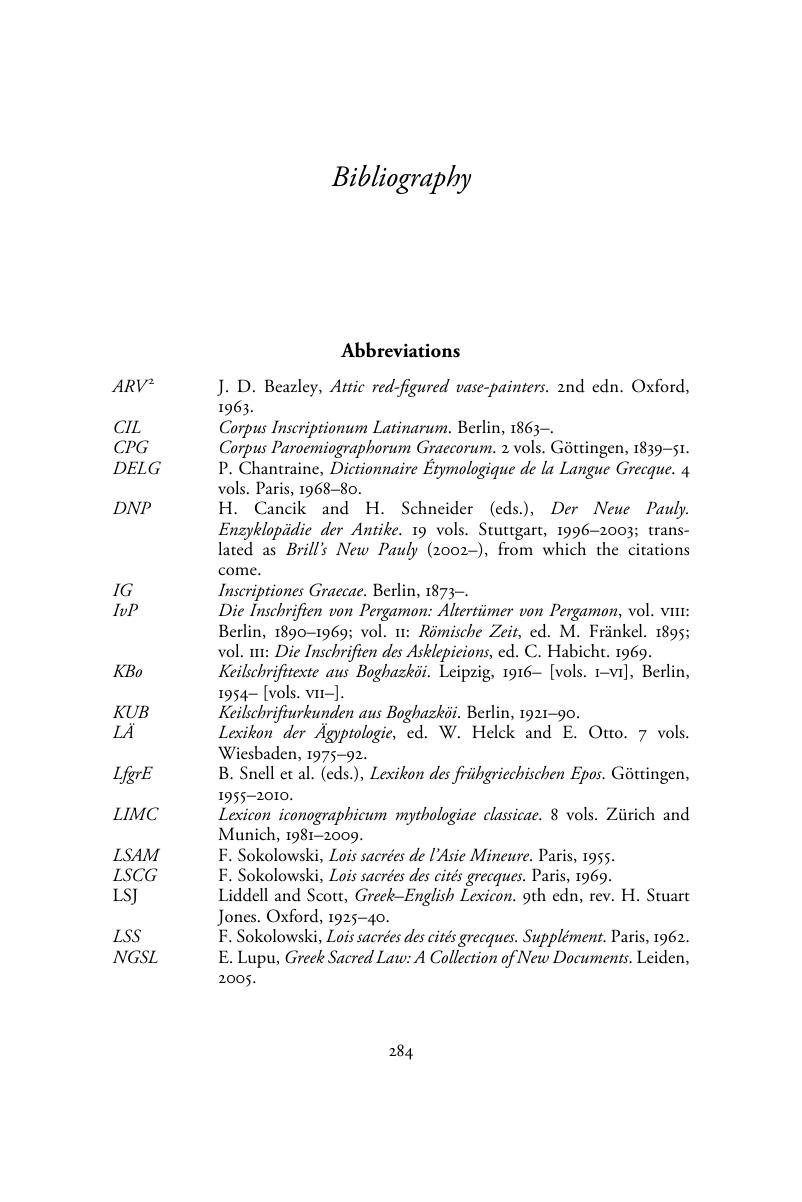Published online by Cambridge University Press: 31 August 2017

J. D. Beazley, Attic red-figured vase-painters. 2nd edn. Oxford, 1963.
Corpus Inscriptionum Latinarum. Berlin, 1863–.
Corpus Paroemiographorum Graecorum. 2 vols. Göttingen, 1839–51.
P. Chantraine, Dictionnaire Étymologique de la Langue Grecque. 4 vols. Paris, 1968–80.
H. Cancik and H. Schneider (eds.), Der Neue Pauly. Enzyklopädie der Antike. 19 vols. Stuttgart, 1996–2003; translated as Brill’s New Pauly (2002–), from which the citations come.
Inscriptiones Graecae. Berlin, 1873–.
Die Inschriften von Pergamon: Altertümer von Pergamon, vol. viii: Berlin, 1890–1969; vol. ii: Römische Zeit, ed. M. Fränkel. 1895; vol. iii: Die Inschriften des Asklepieions, ed. C. Habicht. 1969.
Keilschrifttexte aus Boghazköi. Leipzig, 1916– [vols. i–vi], Berlin, 1954– [vols. vii–].
Keilschrifturkunden aus Boghazköi. Berlin, 1921–90.
Lexikon der Ägyptologie, ed. W. Helck and E. Otto. 7 vols. Wiesbaden, 1975–92.
B. Snell et al. (eds.), Lexikon des frühgriechischen Epos. Göttingen, 1955–2010.
Lexicon iconographicum mythologiae classicae. 8 vols. Zürich and Munich, 1981–2009.
F. Sokolowski, Lois sacrées de l’Asie Mineure. Paris, 1955.
F. Sokolowski, Lois sacrées des cités grecques. Paris, 1969.
Liddell and Scott, Greek–English Lexicon. 9th edn, rev. H. Stuart Jones. Oxford, 1925–40.
F. Sokolowski, Lois sacrées des cités grecques. Supplément. Paris, 1962.
E. Lupu, Greek Sacred Law: A Collection of New Documents. Leiden, 2005.
F. Graf, Nordionische Kulte: religionsgeschichtliche und epigraphische Untersuchungen zu den Kulten von Chios, Erythrai, Klazomenai und Phokaia. Rome, 1985
S. Hornblower and A. Spawforth (eds.), The Oxford Classical Dictionary. 3rd edn. Oxford, 1995.
R. Kassel and C. Austin, Poetae comici Graeci. 8 vols. Berlin, 1983–2001.
Packard Humanities Institute, ‘Searchable Greek Inscriptions’, at epigraphy.packhum.org/inscriptions/main
Paulys Real-Encyclopädie der klassischen Altertumswissenschaft. Stuttgart, 1894–1980.
Supplementum epigraphicum Graecum. Leiden, 1923–.
W. Dittenberger and F. Hiller von Gaertringen (eds.), Sylloge inscriptionum Graecarum. 3rd edn. Leipzig, 1915–24.
Thesaurus cultus et rituum antiquorum. 8 vols. Los Angeles and Basel, 2004–6.
J. D. Beazley, Attic red-figured vase-painters. 2nd edn. Oxford, 1963.
Corpus Inscriptionum Latinarum. Berlin, 1863–.
Corpus Paroemiographorum Graecorum. 2 vols. Göttingen, 1839–51.
P. Chantraine, Dictionnaire Étymologique de la Langue Grecque. 4 vols. Paris, 1968–80.
H. Cancik and H. Schneider (eds.), Der Neue Pauly. Enzyklopädie der Antike. 19 vols. Stuttgart, 1996–2003; translated as Brill’s New Pauly (2002–), from which the citations come.
Inscriptiones Graecae. Berlin, 1873–.
Die Inschriften von Pergamon: Altertümer von Pergamon, vol. viii: Berlin, 1890–1969; vol. ii: Römische Zeit, ed. M. Fränkel. 1895; vol. iii: Die Inschriften des Asklepieions, ed. C. Habicht. 1969.
Keilschrifttexte aus Boghazköi. Leipzig, 1916– [vols. i–vi], Berlin, 1954– [vols. vii–].
Keilschrifturkunden aus Boghazköi. Berlin, 1921–90.
Lexikon der Ägyptologie, ed. W. Helck and E. Otto. 7 vols. Wiesbaden, 1975–92.
B. Snell et al. (eds.), Lexikon des frühgriechischen Epos. Göttingen, 1955–2010.
Lexicon iconographicum mythologiae classicae. 8 vols. Zürich and Munich, 1981–2009.
F. Sokolowski, Lois sacrées de l’Asie Mineure. Paris, 1955.
F. Sokolowski, Lois sacrées des cités grecques. Paris, 1969.
Liddell and Scott, Greek–English Lexicon. 9th edn, rev. H. Stuart Jones. Oxford, 1925–40.
F. Sokolowski, Lois sacrées des cités grecques. Supplément. Paris, 1962.
E. Lupu, Greek Sacred Law: A Collection of New Documents. Leiden, 2005.
F. Graf, Nordionische Kulte: religionsgeschichtliche und epigraphische Untersuchungen zu den Kulten von Chios, Erythrai, Klazomenai und Phokaia. Rome, 1985
S. Hornblower and A. Spawforth (eds.), The Oxford Classical Dictionary. 3rd edn. Oxford, 1995.
R. Kassel and C. Austin, Poetae comici Graeci. 8 vols. Berlin, 1983–2001.
Packard Humanities Institute, ‘Searchable Greek Inscriptions’, at epigraphy.packhum.org/inscriptions/main
Paulys Real-Encyclopädie der klassischen Altertumswissenschaft. Stuttgart, 1894–1980.
Supplementum epigraphicum Graecum. Leiden, 1923–.
W. Dittenberger and F. Hiller von Gaertringen (eds.), Sylloge inscriptionum Graecarum. 3rd edn. Leipzig, 1915–24.
Thesaurus cultus et rituum antiquorum. 8 vols. Los Angeles and Basel, 2004–6.
To save this book to your Kindle, first ensure no-reply@cambridge.org is added to your Approved Personal Document E-mail List under your Personal Document Settings on the Manage Your Content and Devices page of your Amazon account. Then enter the ‘name’ part of your Kindle email address below. Find out more about saving to your Kindle.
Note you can select to save to either the @free.kindle.com or @kindle.com variations. ‘@free.kindle.com’ emails are free but can only be saved to your device when it is connected to wi-fi. ‘@kindle.com’ emails can be delivered even when you are not connected to wi-fi, but note that service fees apply.
Find out more about the Kindle Personal Document Service.
To save content items to your account, please confirm that you agree to abide by our usage policies. If this is the first time you use this feature, you will be asked to authorise Cambridge Core to connect with your account. Find out more about saving content to Dropbox.
To save content items to your account, please confirm that you agree to abide by our usage policies. If this is the first time you use this feature, you will be asked to authorise Cambridge Core to connect with your account. Find out more about saving content to Google Drive.